The five-time world champions unsurprisingly enter the 2022 FIFA World Cup as one of the favourites to win it all. Brazil is the only country in the world to have qualified for every world cup and with such a rich football history, it is only normal for the South American giants to be among the favourites in the World Cup once again.
However, this time around, things are different in the Brazilian headquarters. Tite is the first manager in decades to lead Brazil in consecutive world cups and after a bitter lesson in 2018, the Seleção have significantly evolved tactically. Additionally, this promising generation, who was only entering the world stage four years ago, is coming into this World Cup in full form.
In the South America WC Qualifications, Brazil led the continent with the best campaign in the history of the competition. Without losing a single match, the Seleção scored 40 goals while only conceding five. Under Tite, for over six years now, Brazil have only lost five matches from 76 played. Needless to say, Tite has the experience and full control of this talented Brazil side as they search for a historic sixth-world title. With some of the world’s best players in Real Madrid’s Vini Jr. and PSG’s Neymar and Marquinhos, there is no shortage of talent in Tite’s squad.
This scout report in the form of a tactical analysis aims to break down Brazil’s tactics under Tite in the 61-year-old manager’s second World Cup cycle. In addition to looking at the Seleção tactics throughout all four phases of play, this analysis will also provide a detailed insight into Brazil’s squad as they challenge for the unprecedented Hexa.
Predicted Starting XI
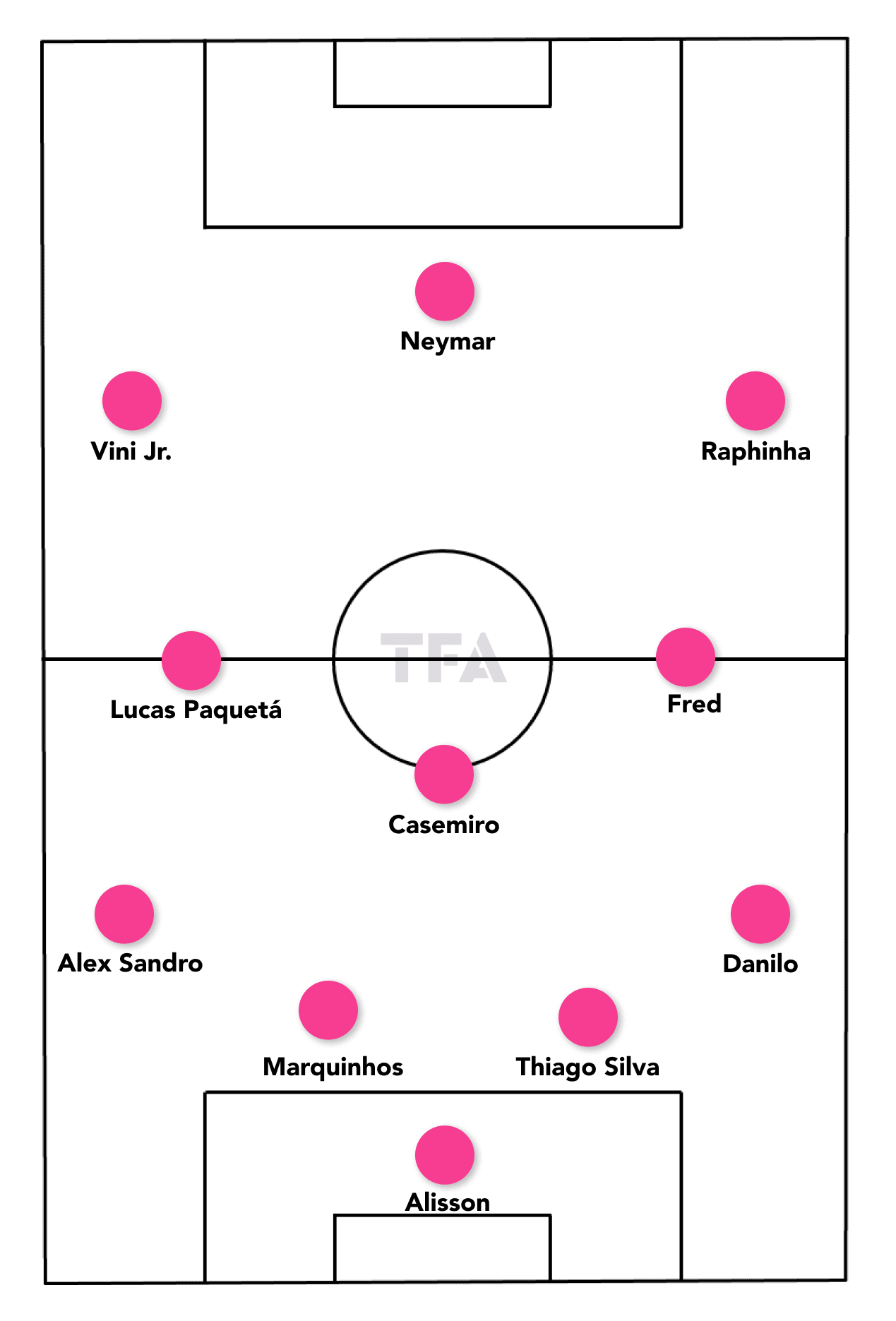
Over the past year, Tite has experimented with a number of players and variations while still adhering to his uncompromisable style of play. Brazil have numerous world stars with varying characteristics, and Tite looks to maximise each individual’s ability while still ensuring collective organisation and balance.
At any rate, he has often fallen back to the same group of players for his starting XI. Although these players generally form a 4-3-3, the actual shape during the game is constantly changing. Tite adopts a strict positional play system, and under these rules, Brazil have numerous variations.
With Alisson being the undisputed first choice in goal, Tite prefers a backline of Danilo, Thiago Silva, Marquinhos, and Alex Sandro. However, with Alex Sandro’s recent drop in form at Juventus, Alex Telles could be a direct replacement. In the midfield, Man United’s midfield duo of Casemiro and Fred is used. Lucas Paquetá is a more advanced player flanked by Vini Jr. and Raphinha. Finally, as more of a false nine, Neymar leads the line. In possession, this is far from a regular 4-3-3, and with numerous world-class players also available, changes could be made here and there.
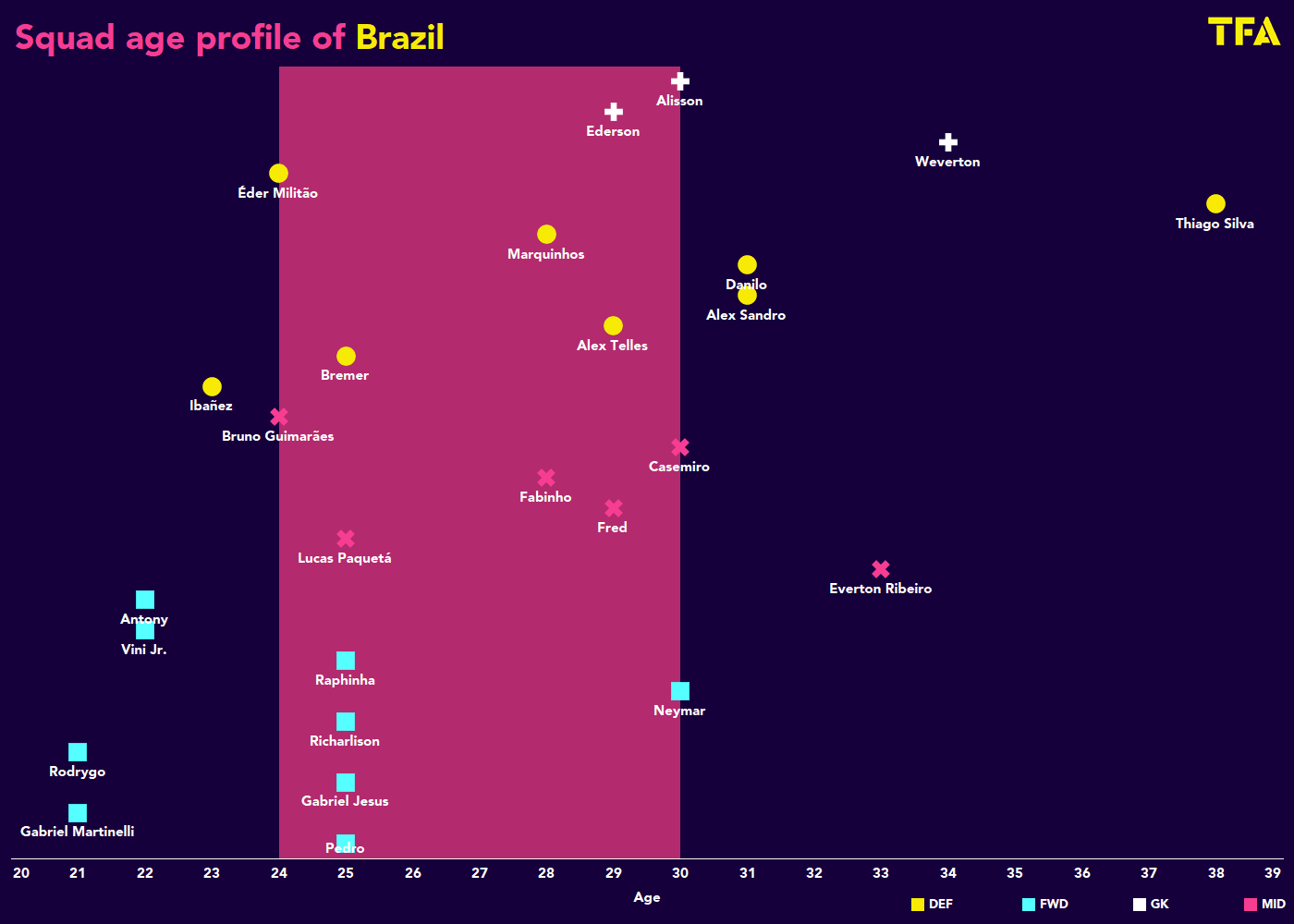
Brazil’s age profile further emphasises this squad’s growth and maturity compared to the 2018 World Cup. With a few deadwood players falling out of the picture, young and emerging stars have entered the stage. There are still experienced leaders such as Alex Sandro, Casemiro, and Thiago Silva. However, the addition of players like Antony, Rodrygo, Vini Jr., Raphinha, and Bruno Guimarães brings a whole new face to Tite’s side. With a balance between youth and experience, Brazil come to Qatar with one of the best squads in the competition.
Attacking Phase
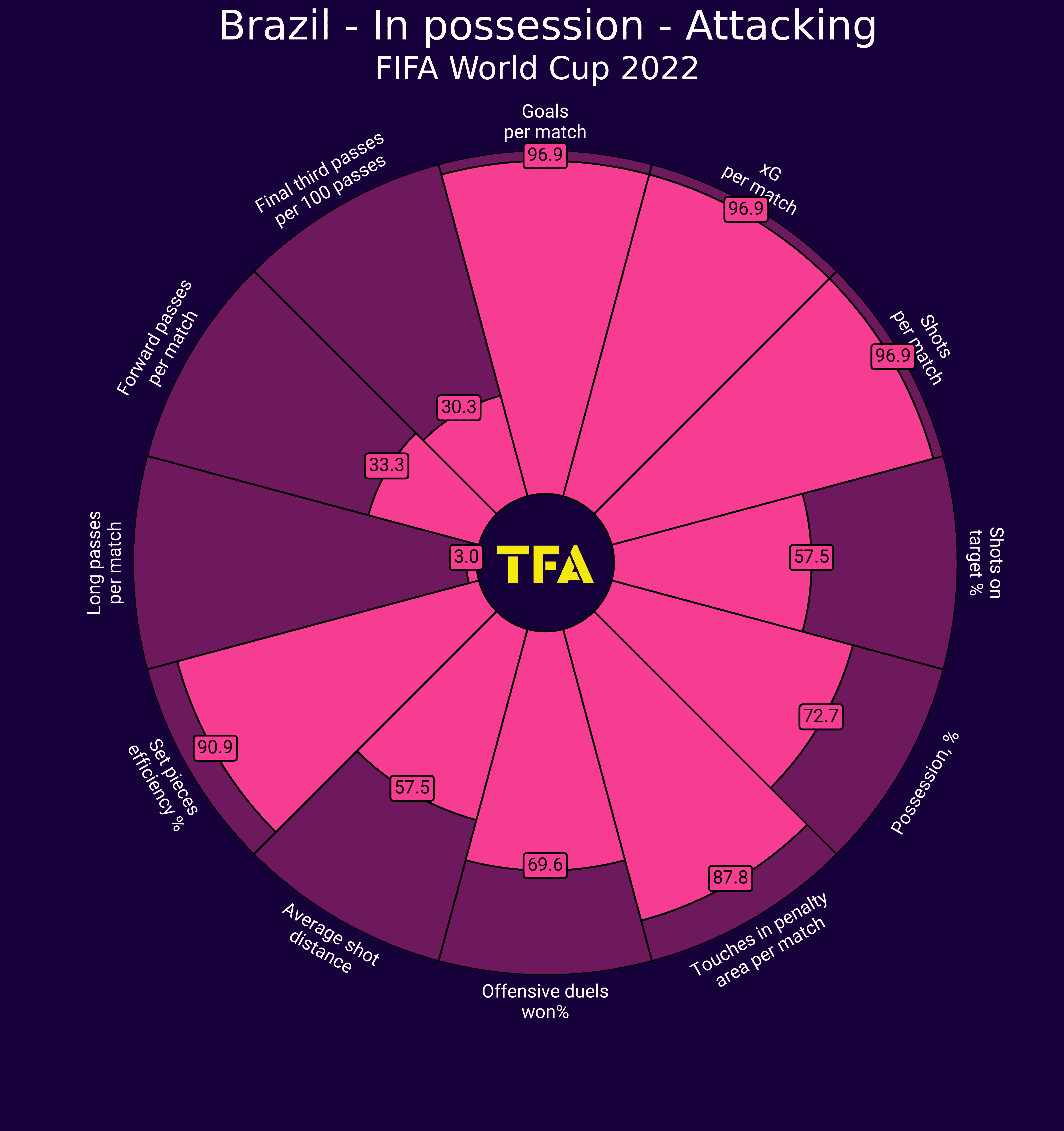
Statistically, Brazil’s attacking output cannot be denied. Among all nations in the World Cup, Brazil rank in the 96.9th percentile for goals per match, xG per match, and shots per match. Additionally, their 87.8th percentile for touches in the penalty area per match only further highlights their attacking volume. Tite’s side like to dominate possession — ranking in the 72.7th percentile for it — while still maintaining a high chance creation volume.
Furthermore, their extremely low 3rd percentile in long balls per match illustrates their rather controlled approach with the ball, looking to progress through the zones with absolute control and superiority.
More specifically, in 2022, the Seleção averaged 524.13 passes per 90 with only 5.61% of them being long. Their 215.13 lateral passes per 90 are also much higher than their 142.63 forward passes per 90. These metrics serve to highlight the incredible control Tite has introduced to the Seleção. They are looking to ensure absolute control over matches and allow the opposition little to no time on the ball. By maintaining maximum organisation, they also ensure optimal and structured chance creation.
As mentioned, since 2018, Tite has adopted a positional play system in possession. As such, Brazil’s actions in possession, both on and off the ball, have become much more systematic and structured. Regardless of the formation or players, there are numerous variations Brazil use in possession. The most common is the 3-2-5 famously used by Pep Guardiola at Man City.
There are multiple ways they can form this structure, and it all depends on the players on the pitch. In the example below, Alex Telles drops to become the third centre-back while Danilo forms a double pivot with Casemiro in the midfield. When the ball is on the other side, the opposite can happen. Tite’s men are extremely flexible and fluid.
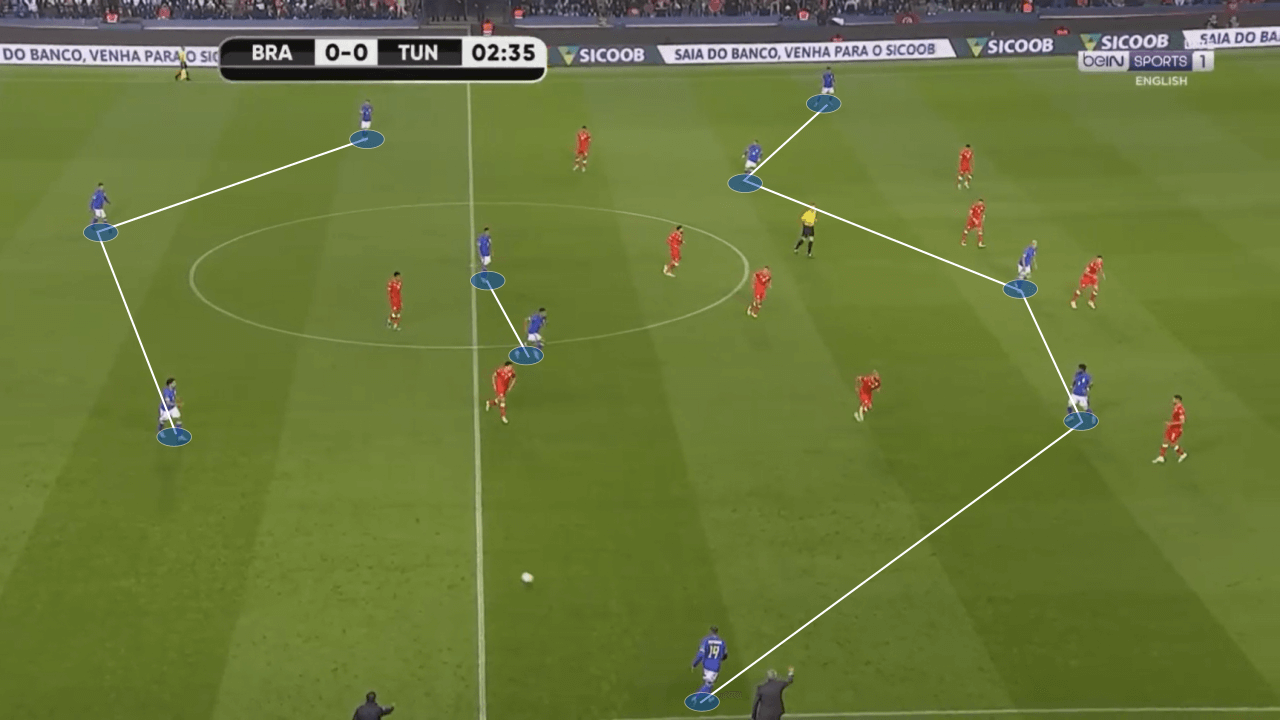
In the example below, Brazil begin in a 4-2-4 structure, with the front line pinning Japan’s backline. As Marquinhos initiates the attack, Fred pushes higher to pin the opposition’s midfielder. With the space created by Fred’s movement, Dani Alves can push inside and become the second midfielder. Fred then moves to Dani Alves’ previous position, where he receives the ball and progresses into the final third.
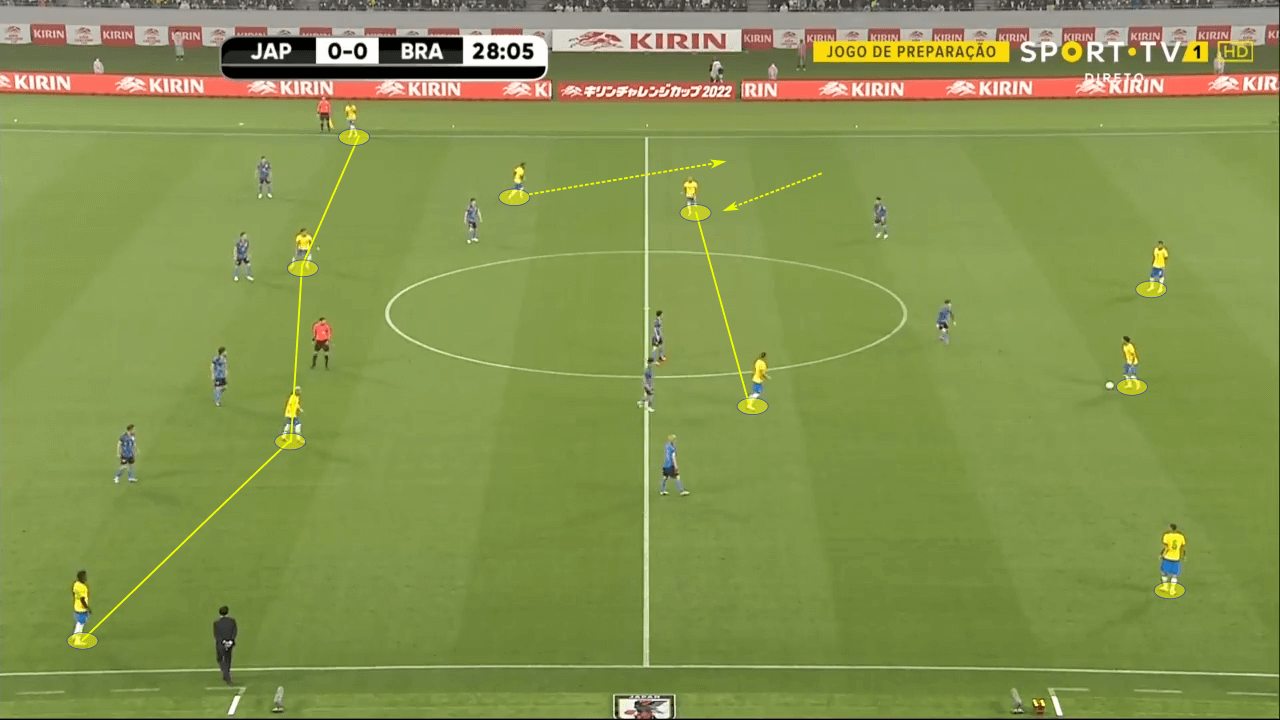
By maintaining maximum width in this positional play structure, Brazil are constantly able to stretch the opposition’s defensive blocks. This often leaves the wide players in 1v1 scenarios, and with some of the best wingers in the world, this is extremely favourable for the Seleção. Additionally, by stretching the opposition’s defensive organisation, there is significant space for Neymar to roam and create opportunities.
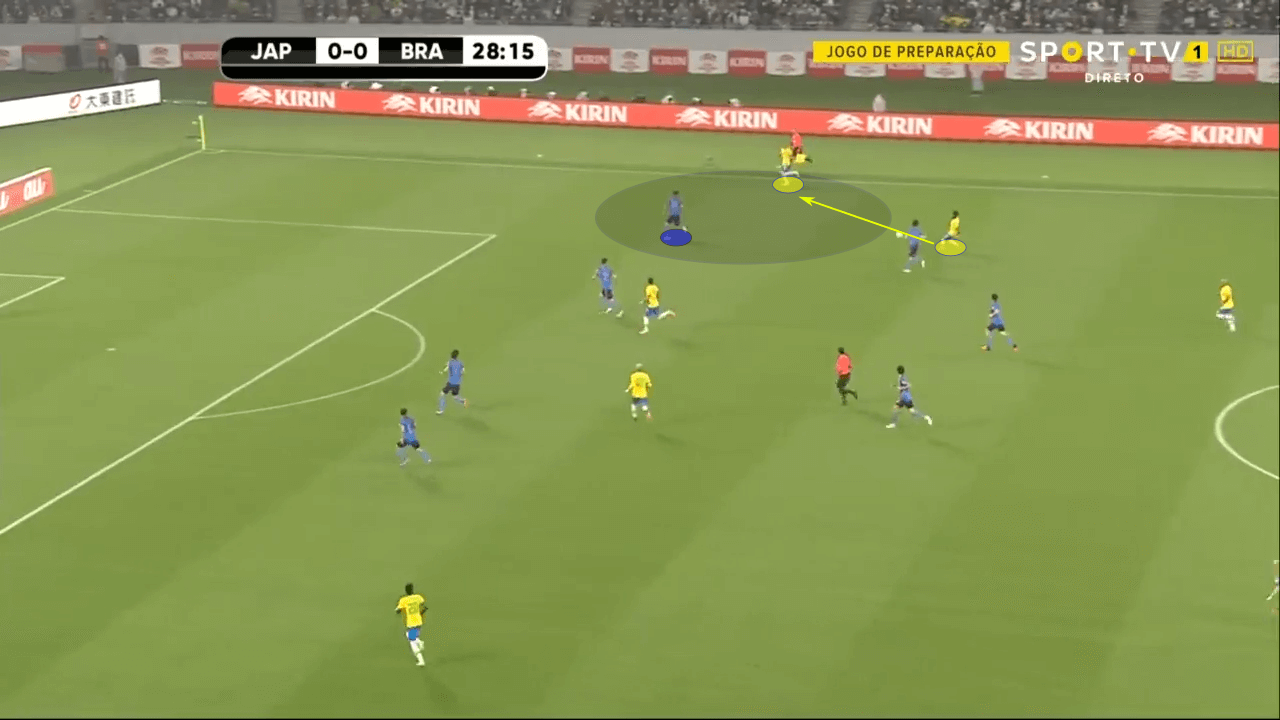
After a traumatising loss to Belgium in 2018, Tite wants to leave nothing to chance. Since then, the 61-year-old manager has adopted a dominant approach in possession where they seek to minimise the chaos and have absolute control of the match. With a positional play system guiding them forward, Brazil’s attack in recent years has been extremely dangerous.
Defensive Phase
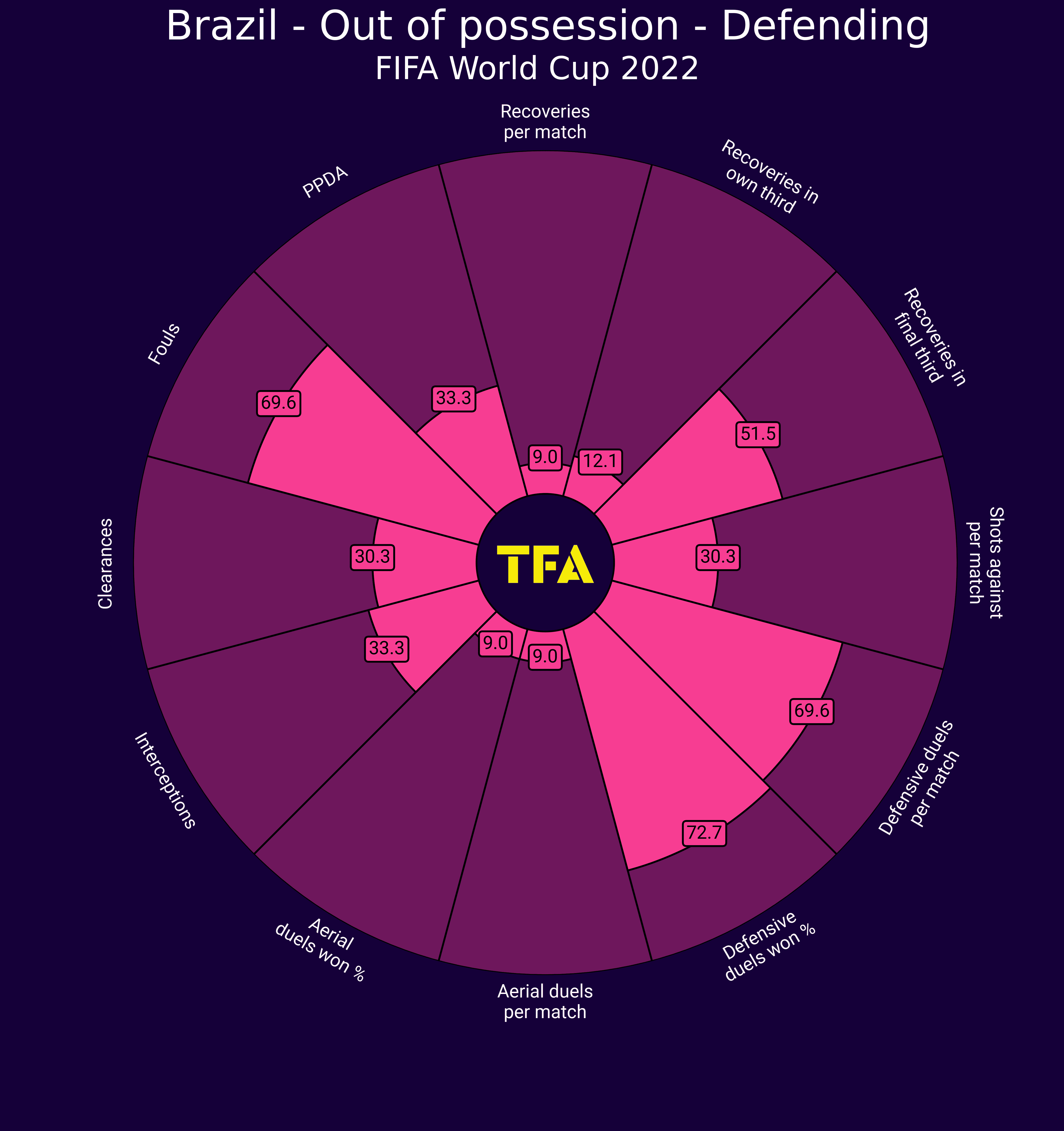
Unsurprisingly, Brazil rank extremely low for most defensive metrics. This is a direct result of their absolute control in matches, where they defend for very insignificant periods. Nonetheless, their tactics in the defensive phase still play a large role in ensuring their desired domination. For both defensive duels per match and the percentage of defensive duels won, they rank quite high. Their PPDA is in the low 33.33rd percentile, and finally, their 51.5th percentile for recoveries in the final third indicates their advanced defensive approach.
Brazil look to press in a structured yet incredibly aggressive manner. Tite wishes to recover the ball as early as possible, and this begins with an intense high defensive block. Below, as Argentina, begin their build-up on the left-hand side, Brazil shift their entire high block over. The press is initially led by two players, and as the ball is played to either side, one player will pressure the centre-back while the other tucks in on the opposition’s defensive midfielder. With their block moved over, they adopt a man-to-man press and aim to keep the opposition from progressing into the midfield third.
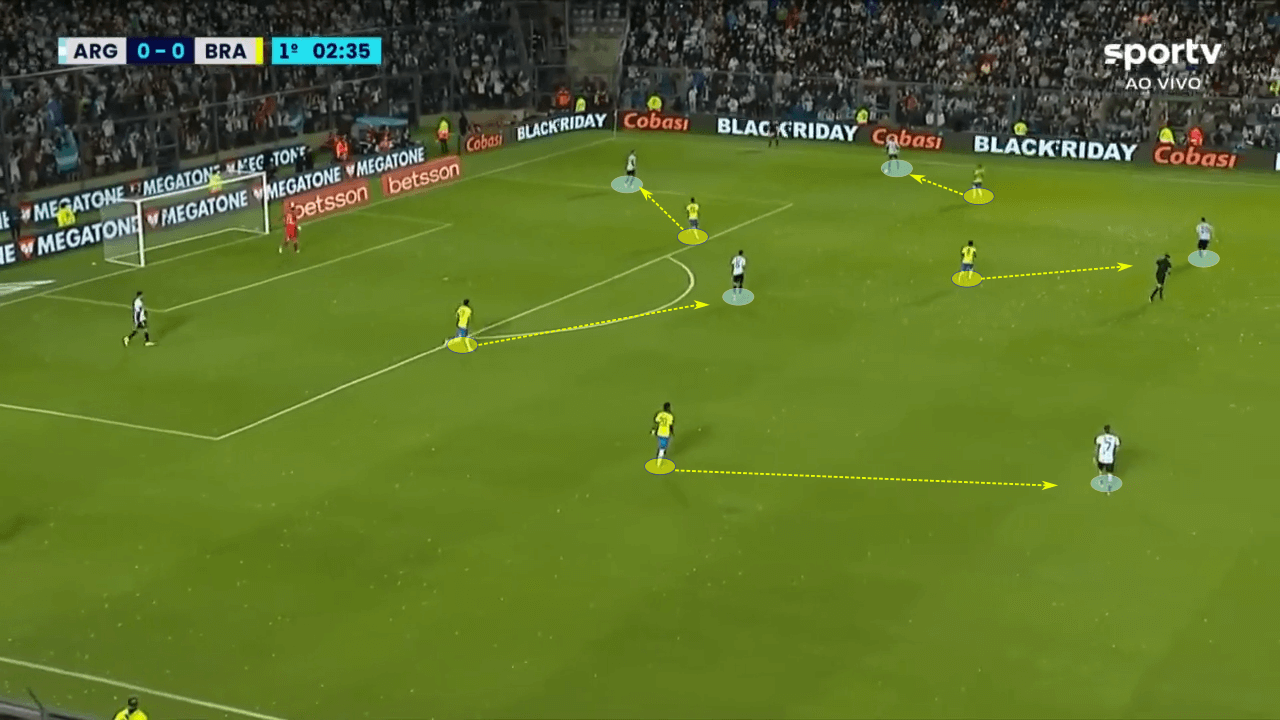
Their high press is also conducted in a very compact manner. As they try to overwhelm the opposition into giving the ball away, they significantly reduce the playing area by remaining compact and narrow. As a consequence, when the ball is played into certain areas, they can collective jump on it and pressure the receiver. In the example below, as Venezuela attempt to play into the midfield, Brazil surround the receiver with five players and force him to commit an error.
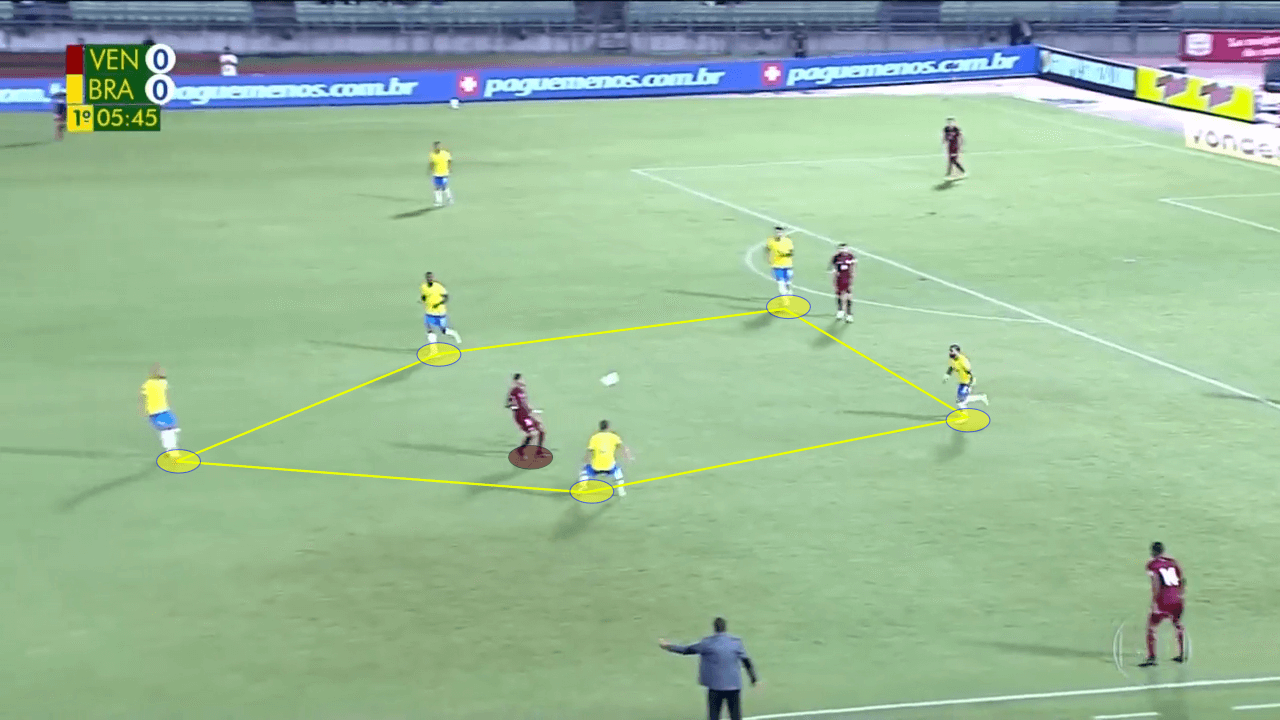
In lower blocks, although it does not happen often, Brazil revert to a traditional 4-4-2 with two very compact lines of four. In a zonal organisation, the Seleção demonstrate impressive coordination and communication as they keep the opposition from reaching the final third. They also aim to constantly have superiority around the ball with an extra man to cover, especially in the wide areas.
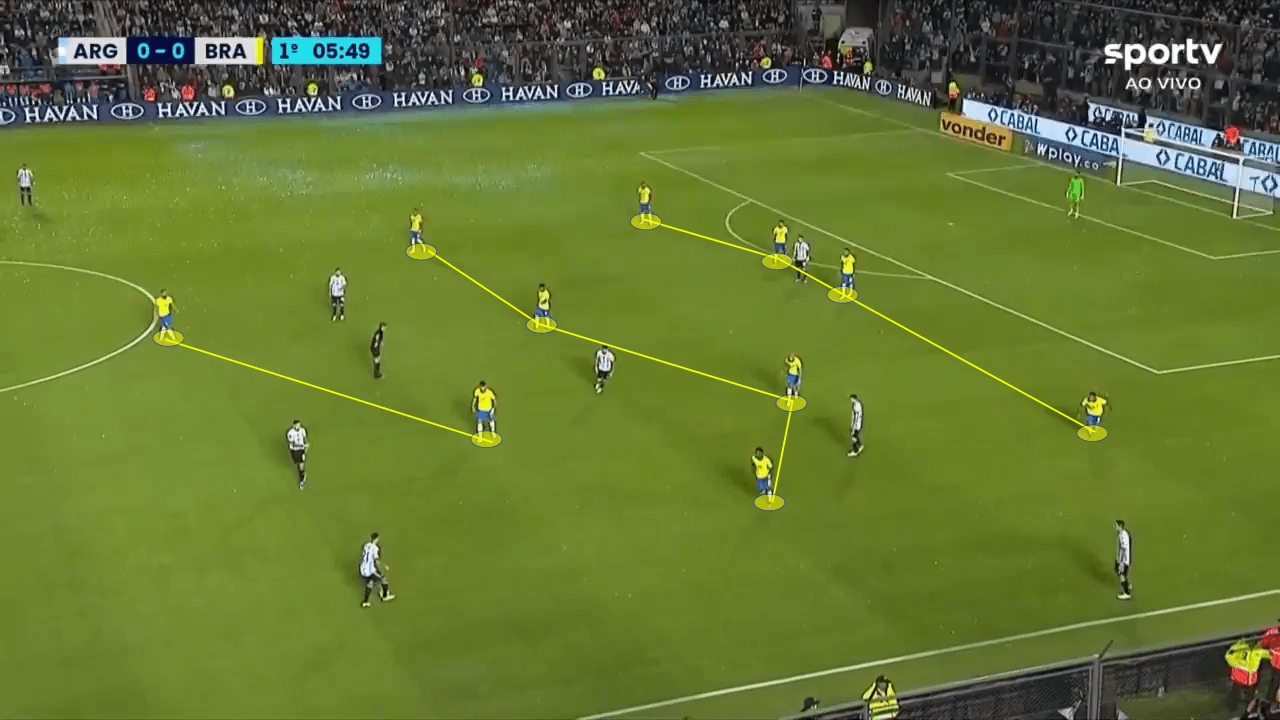
Transitions
In transitional phases, Tite maintains an approach consistent with the other phases. The transition to the transitions is key, and that is what Tite has tried to implement with conscious attacking and defending organisations. In possession, part of their organisation is to ensure they can immediately counter-press and keep the opposition from countering should they recover the ball. Once the ball is lost, the players nearest to it will immediately provide pressure while attempting to close off near-passing lanes. If the ball is not immediately recovered, the objective is to delay the opposition’s attack to get reorganised defensively.
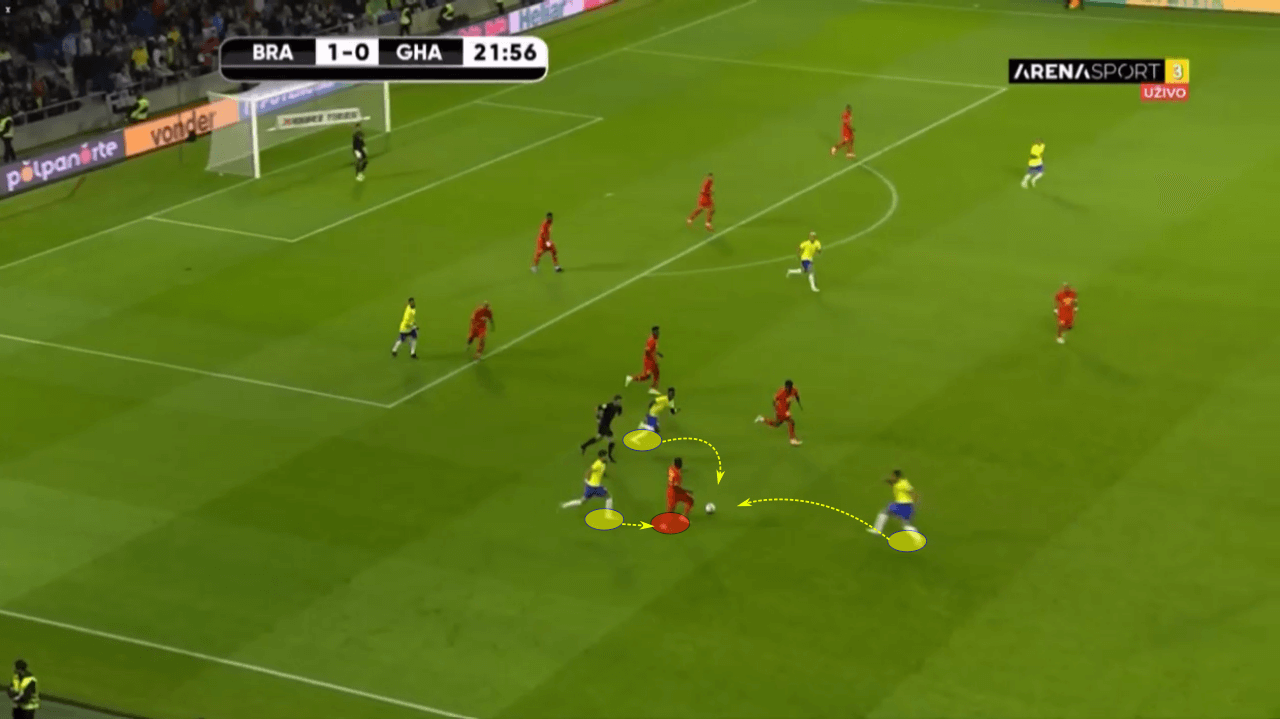
Similarly, their defensive structure is conscious and prepared for their attacking transitions. As examined, their high press is extremely compact, often having numerous players around the ball. When the ball is recovered in the opposition’s half, they already have a significant number of players to begin an attacking transition. In the example below, when Casemiro recovers the ball in the middle third, he immediately has four Brazilian players around him.
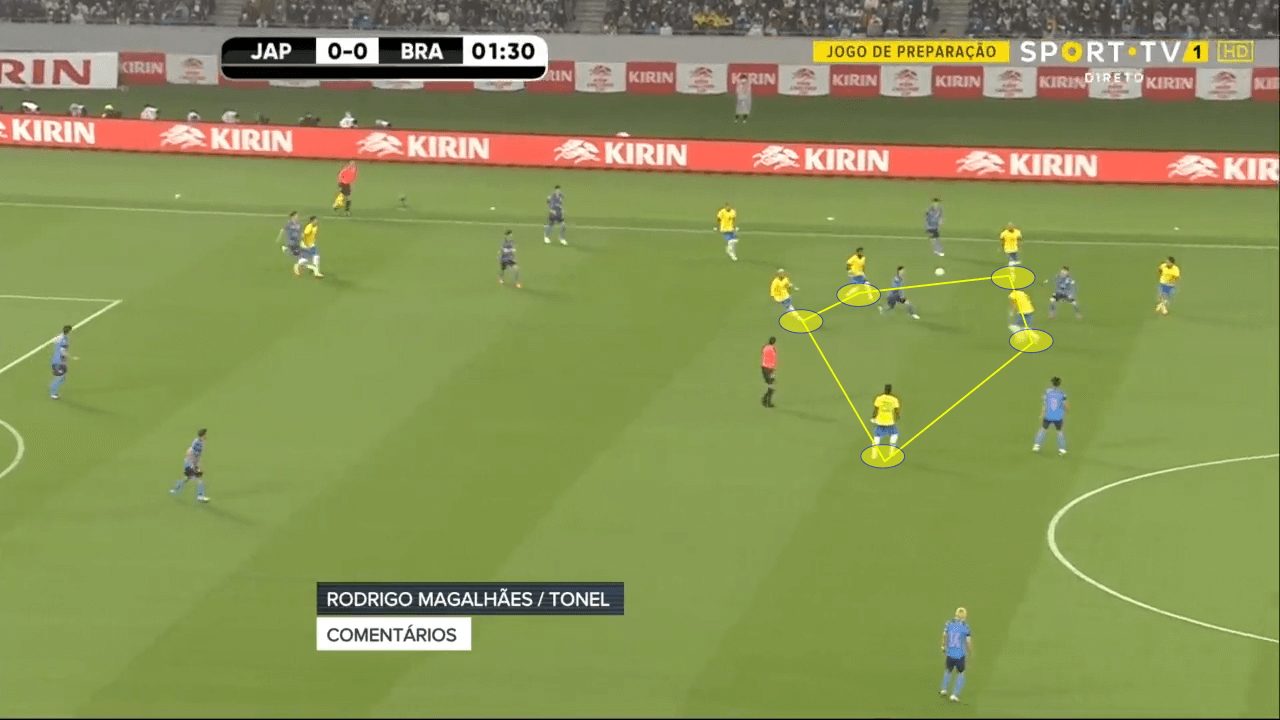
When launching counterattacks from deeper positions, Brazil are very good at working together to exploit a disorganised defensive organisation. In these transition scenarios, they are very conscious of their movements, especially without the ball. Constantly looking to manipulate and create space, Brazil’s overwhelming talent tends to wreak havoc in attacking transitions.
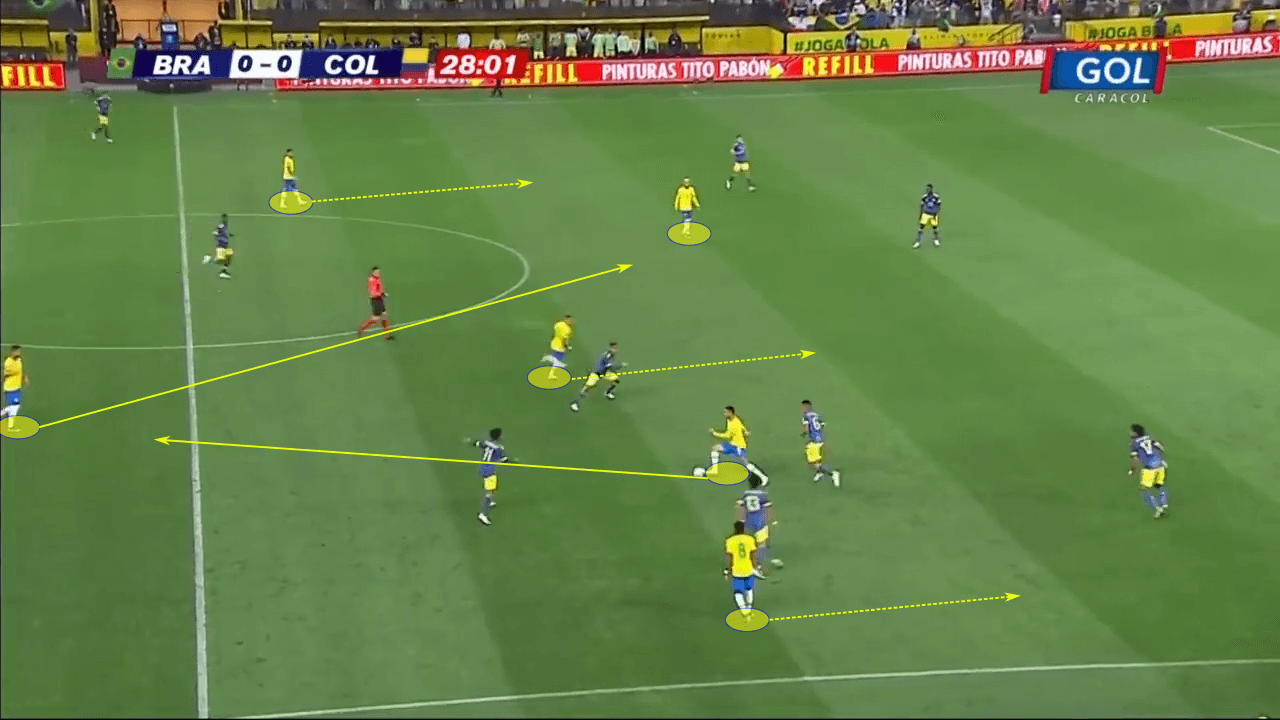
Attackers
Throughout history, Brazil have consistently produced some of the best forwards in the world. In 2022, this is no different. Brazil come to Qatar with an incredible production line in the attack. With numerous Brazilian stars entering the world stage in recent years, the Seleção’s newest generation is becoming a reality. Neymar is still the star player and leader of this attack, but for the first time in his career, he has world-class players alongside him. Players like Vini Jr., Raphinha, and Antony have been leading the world’s biggest clubs.
This season, Neymar is averaging 0.8 goals per 90 on top of 0.64 assists per 90. Similarly, Vini is averaging 0.39 goals per 90 while Raphinha has 0.4 goals per 90. The Seleção’s forwards are coming into the 2022 World Cup with undeniable form, and should they continue this in Qatar, Brazil’s attack will be a force to be reckoned with.
Midfielders
Tite’s midfield can be broken down into two parts. The first is the more deep-lying role, which can be performed by Casemiro or Fabinho. Unlike in 2018, when Casemiro was absent in the Belgium game, Tite finally has a replacement at the same level. The other role tends to be performed by either Fred or Bruno Guimarães, and it is a slightly more advanced one. Lucas Paquetá belongs more in the forward unit, although he does tend to occupy the midfield in possession. Flamengo’s Everton Ribeiro has been in tremendous form in 2022, and with Philippe Coutinho significantly dropping in form, the 33-year-old should make an appearance in Tite’s Qatar squad.
In summary, Brazil will have around six midfield players who can perform a variety of roles. This time around, there is quality all-around, with no significant drop in level should somebody get injured or suspended.
Defenders
The Seleção have always had world-class fullbacks. From Roberto Carlos to Cafu, Brazil have always had reliable and consistent fullbacks. However, this time around, there is a significant lack of depth wide. In the last national team call-up, Tite opted for one right-back and five centre-backs in the squad, with Éder Militão being able to play as a right-back if needed. A similar approach should be taken in the final squad, especially as Danilo seems to be the only natural option on the right. On the left, Alex Sandro and Alex Telles should be the two options as Guilherme Arana is out with an injury.
As far as centre-backs, Thiago Silva, Marquinhos, and Éder Militão are guaranteed. The last one or two spots will be decided between Arsenal’s Gabriel Magalhães, Juventus’ Bremer, and Roma’s Ibañez. At any rate, Brazil come into this World Cup with an extremely solid defensive system.
Key player
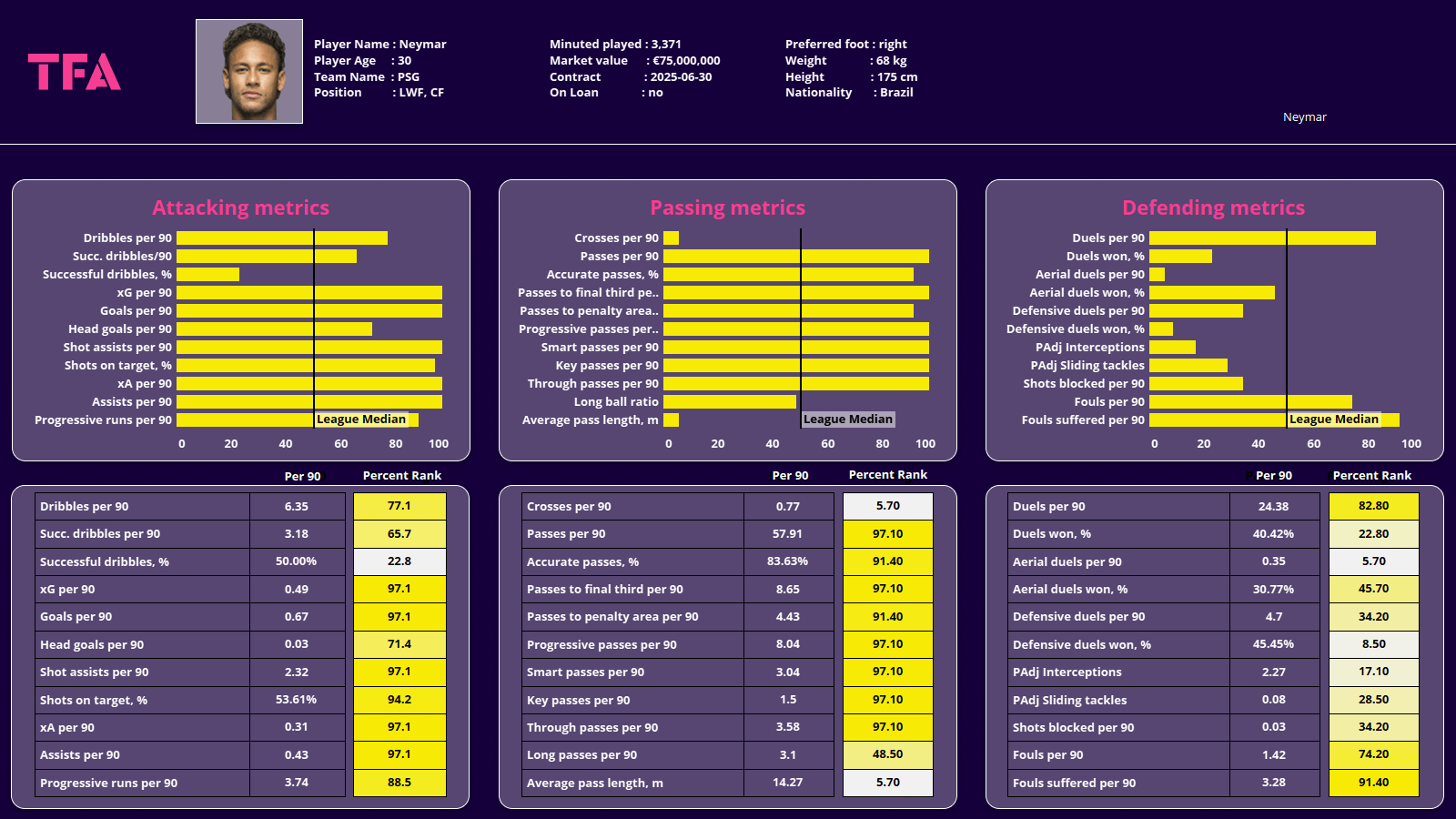
There is not much doubt regarding Brazil’s best performer. Neymar has entered this season flying with PSG, already having contributed to 27 goals in just over two months. The 30-year-old’s attacking and passing metrics are extremely above average, with most of them ranking in the top percentiles. His 97.1st percentile for both xG per 90 and goals per 90 is incredible, especially when put alongside his 97.1st percentile for both xA per 90 and assists per 90.
Neymar’s attacking output is one of the best in the world. If the PSG star continues his club form into the World Cup, it will be very hard to stop Brazil’s attack.
Tournament Prediction
It is no surprise that Brazil enter the 2022 FIFA World Cup as one of the favourites to win it all. Along with France, the Seleção have one of the best squads coming into the competition. Their performance in the South American qualifications was beyond impressive, and with a much more evolved squad from 2018, it will be hard to stop them from lifting their sixth-world title.

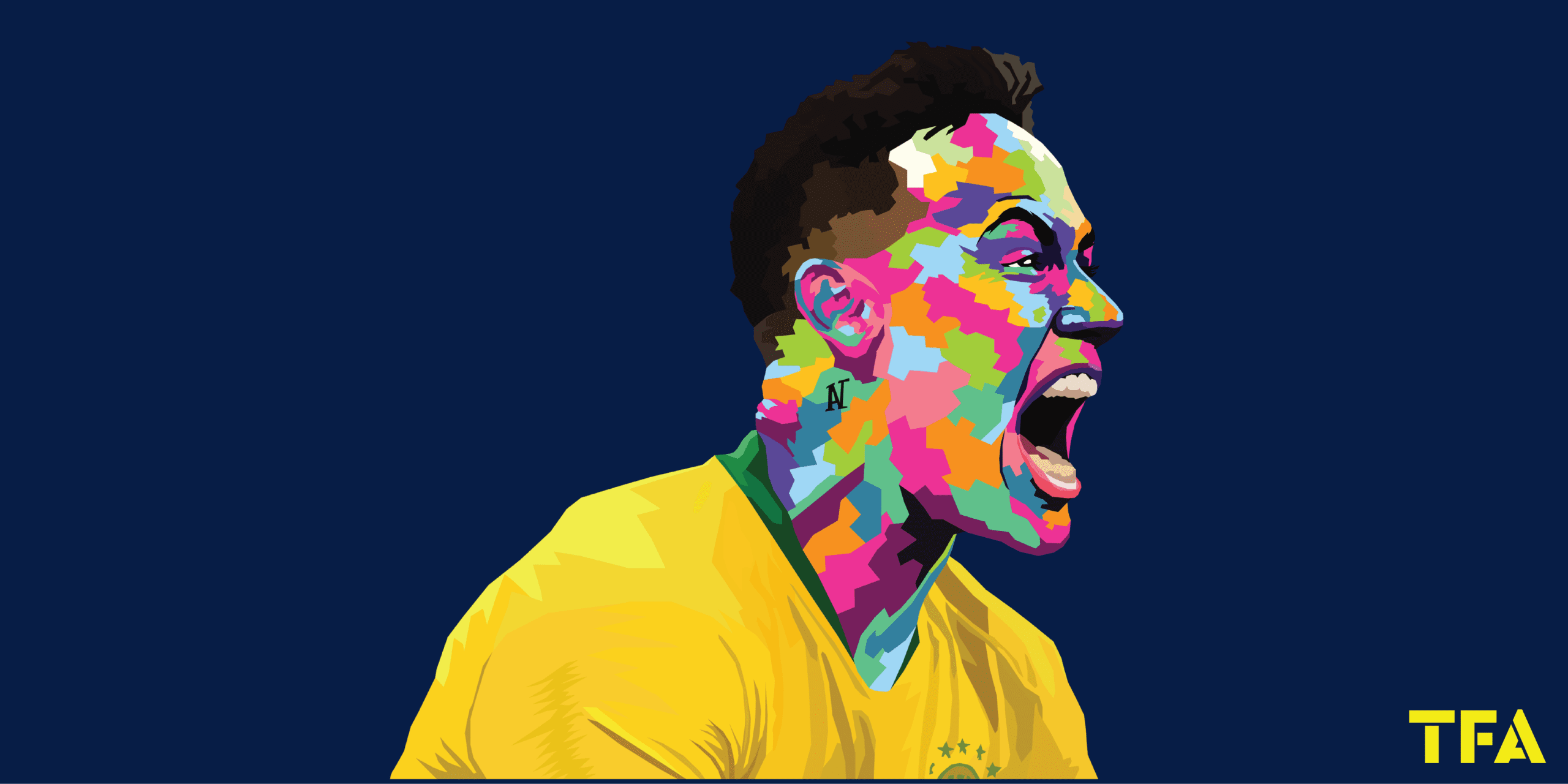



Comments